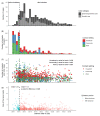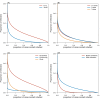Case clustering, contact stratification, and transmission heterogeneity of SARS-CoV-2 Omicron BA.5 variants in Urumqi, China: An observational study
- PMID: 37199483
- PMCID: PMC10193892
- DOI: 10.7189/jogh.13.06018
Case clustering, contact stratification, and transmission heterogeneity of SARS-CoV-2 Omicron BA.5 variants in Urumqi, China: An observational study
Abstract
Background: From August to September 2022, Urumqi, the capital of the Xinjiang Uygur Autonomous Region in China, faced its largest COVID-19 outbreak caused by the emergence of the SARS-CoV-2 Omicron BA.5.2 variants. Although the superspreading of COVID-19 played an important role in triggering large-scale outbreaks, little was known about the superspreading potential and heterogeneity in the transmission of Omicron BA.5 variants.
Methods: In this retrospective observational, contact tracing study, we identified 1139 laboratory-confirmed COVID-19 cases of Omicron BA.5.2 variants, and 51 323 test-negative close contacts in Urumqi from 7 August to 7 September 2022. By using detailed contact tracing information and exposure history of linked case-contact pairs, we described stratification in contact and heterogeneity in transmission across different demographic strata, vaccine statuses, and contact settings. We adopted beta-binomial models to characterise the secondary attack rate (SAR) distribution among close contacts and modelled COVID-19 transmission as a branching process with heterogeneity in transmission governed by negative binomial models.
Results: After the city lockdown, the mean case cluster size decreased from 2.0 (before lockdown) to 1.6, with decreased proportions of contacts in workplace and community settings compared with household settings. We estimated that 14% of the most infectious index cases generated 80% transmission, whereas transmission in the community setting presented the highest heterogeneity, with 5% index cases seeding 80% transmission. Compared with zero, one, and two doses of inactivated vaccine (Sinopharm), index cases with three doses of vaccine had a lower risk of generating secondary cases in terms of the reproduction number. Contacts of female cases, cases with ages 0-17 years, and household settings had relatively higher SAR.
Conclusions: In the context of intensive control measures, active case detection, and relatively high vaccine coverage, but with an infection-naive population, our findings suggested high heterogeneity in the contact and transmission risks of Omicron BA.5 variants across different demographic strata, vaccine statuses, and contact settings. Given the rapid evolution of SARS-CoV-2, investigating the distribution of transmission not only helped promote public awareness and preparedness among high-risk groups, but also highlighted the importance of continuously monitoring the transmission characteristics of genetic variants of SARS-CoV-2.
Copyright © 2023 by the Journal of Global Health. All rights reserved.
Conflict of interest statement
Disclosure of interest: The authors completed the ICMJE Disclosure of Interest Form (available upon request from the corresponding author) and disclose no relevant interests.
Figures




Similar articles
-
Transmission Characteristics and Inactivated Vaccine Effectiveness Against Transmission of SARS-CoV-2 Omicron BA.5 Variants in Urumqi, China.JAMA Netw Open. 2023 Mar 1;6(3):e235755. doi: 10.1001/jamanetworkopen.2023.5755. JAMA Netw Open. 2023. PMID: 36995713 Free PMC article.
-
Effectiveness of the booster dose of inactivated COVID-19 vaccine against Omicron BA.5 infection: a matched cohort study of adult close contacts.Respir Res. 2023 Oct 12;24(1):246. doi: 10.1186/s12931-023-02542-y. Respir Res. 2023. PMID: 37828565 Free PMC article.
-
Transmission risks of Omicron BA.5 following inactivated COVID-19 vaccines among children and adolescents in China.Commun Med (Lond). 2024 May 18;4(1):92. doi: 10.1038/s43856-024-00521-y. Commun Med (Lond). 2024. PMID: 38762678 Free PMC article.
-
Factors Associated With Household Transmission of SARS-CoV-2: An Updated Systematic Review and Meta-analysis.JAMA Netw Open. 2021 Aug 2;4(8):e2122240. doi: 10.1001/jamanetworkopen.2021.22240. JAMA Netw Open. 2021. PMID: 34448865 Free PMC article.
-
Assessing changes in incubation period, serial interval, and generation time of SARS-CoV-2 variants of concern: a systematic review and meta-analysis.BMC Med. 2023 Sep 29;21(1):374. doi: 10.1186/s12916-023-03070-8. BMC Med. 2023. PMID: 37775772 Free PMC article.
Cited by
-
Impact of disease severity, age, sex, comorbidity, and vaccination on secondary attack rates of SARS-CoV-2: a global systematic review and meta-analysis.BMC Infect Dis. 2025 Feb 13;25(1):215. doi: 10.1186/s12879-025-10610-5. BMC Infect Dis. 2025. PMID: 39948450 Free PMC article.
-
Epidemiological Analysis of the COVID-19 Clusters in the Early Stages of the Epidemic in Shanghai, China: Pandemic-to-Epidemic Response Shift.Trop Med Infect Dis. 2025 Jun 17;10(6):170. doi: 10.3390/tropicalmed10060170. Trop Med Infect Dis. 2025. PMID: 40559737 Free PMC article.
References
-
- World Health Organization. Classification of Omicron (B.1.1.529): SARS-CoV-2 Variant of Concern. Available: https://www.who.int/news/item/26-11-2021-classification-of-omicron-(b.1..... Accessed: 21 October 2022.
-
- World Health Organization. Weekly epidemiological update on COVID-19 - 19 October 2022. Available: https://www.who.int/publications/m/item/weekly-epidemiological-update-on.... 19 October 2022).
-
- Chen Z, Deng X, Fang L, Sun K, Wu Y, Che T, et al. Epidemiological characteristics and transmission dynamics of the outbreak caused by the SARS-CoV-2 Omicron variant in Shanghai, China: A descriptive study. Lancet Reg Health West Pac. 2022;29:100592. 10.1016/j.lanwpc.2022.100592 - DOI - PMC - PubMed
Publication types
MeSH terms
LinkOut - more resources
Full Text Sources
Medical
Miscellaneous
